Avez-vous déjà oublié la clé de votre maison et vous êtes-vous senti épinglé à l’extérieur ? Se retrouver bloqué hors de votre site WordPress peut ressembler à cela. C’est très frustrant, surtout si des pirates ont supprimé votre compte administrateur. Mais ne vous inquiétez pas, vous pouvez y retourner.
Imaginez votre site comme une maison avec une porte arrière secrète. Cette porte dérobée est la base de données de votre site, à laquelle on accède généralement à l’aide du code MySQL. Cela peut paraître compliqué, mais il s’agit en fait d’un ensemble d’instructions que vous pouvez utiliser pour apporter des modifications à votre site en coulisses.
Dans cet article, nous allons vous apprendre à utiliser MySQL pour créer un tout nouveau compte d’administration pour votre site, tout comme vous feriez fabriquer une nouvelle clé pour votre maison. Vous pourrez ainsi exclure les pirates et reprendre le contrôle de votre site.
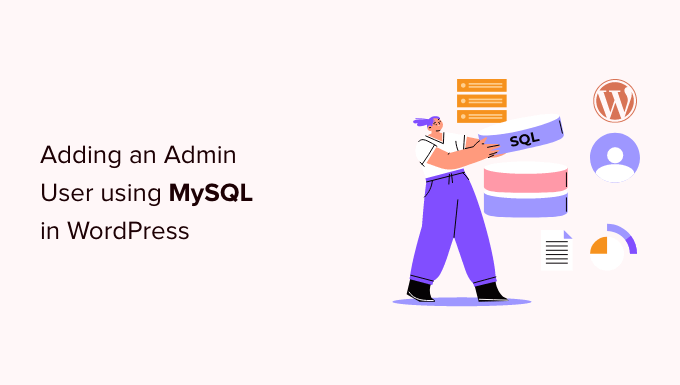
Pourquoi ajouter un utilisateur/utilisatrice à la base de données de WordPress via MySQL ?
Nous avons rencontré une fois un problème où le site d’un utilisateur a été piraté, et son compte admin a été supprimé de la base de données. Cela l’a empêché d’accéder à son site WordPress.
Nous avons pu les aider à accéder à leur site en créant un nouvel utilisateur/utilisatrice administrateur directement sur le site WordPress. Pour ce faire, nous avons utilisé phpMyAdmin, un outil web qui vous permet de gérer les bases de données MySQL à l’aide de votre navigateur.
Si vous vous trouvez bloqué hors de votre zone d’administration WordPress à cause de pirates ou simplement parce que vous avez oublié votre mot de passe, alors vous pouvez faire de même.
Cependant, vous devriez toujours faire une sauvegarde de votre base de données avant d’effectuer des modifications sur MySQL. Ensuite, une fois que vous pourrez vous connecter à nouveau à votre site, vous devrez peut-être suivre notre guide du débutant pour corriger votre site WordPress piraté.
Ceci étant dit, voyons comment ajouter un utilisateur/utilisatrice administrateur à la base de données de WordPress via MySQL.
Ajout d’un utilisateur/utilisatrice dans la base de données de WordPress avec phpMyAdmin
phpMyAdmin est préinstallé chez la plupart des entreprises d’hébergement WordPress. Vous le trouverez dans la section Bases de données du tableau de bord cPanel de votre compte d’hébergement.
Voici une capture d’écran du panneau de contrôle de Bluehost :
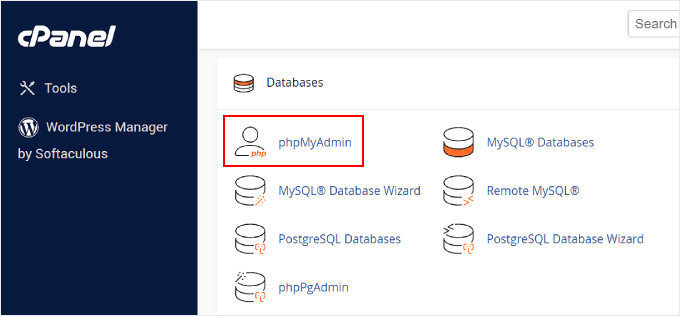
En cliquant sur l’icône, vous ouvrirez l’interface de phpMyAdmin. Vous devez sélectionner votre base de données WordPress dans la colonne de gauche.
Ensuite, phpMyAdmin affichera toutes les tables de votre base de données WordPress. Vous allez apporter des modifications aux tables wp_users et wp_usermeta.
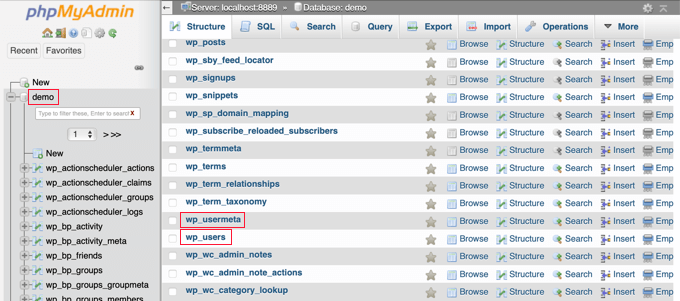
Ajout d’un compte dans la table wp_users
Tout d’abord, vous devez trouver le tableau wp_users et cliquer dessus. Cela affichera les utilisateurs/utilisatrices actuellement répertoriés dans le tableau.
Notez dans la capture d’écran ci-dessous qu’il y a deux ID d’utilisateur dans le tableau de notre site de démonstration, 1 et 2. Lorsque nous créons un nouvel utilisateur pour notre site de démonstration, cet ID doit être unique, nous allons donc taper le chiffre 3.
Vous devez cliquer sur l’onglet “Insérer” en haut de l’écran afin d’insérer les informations relatives à un nouvel utilisateur/utilisatrice.
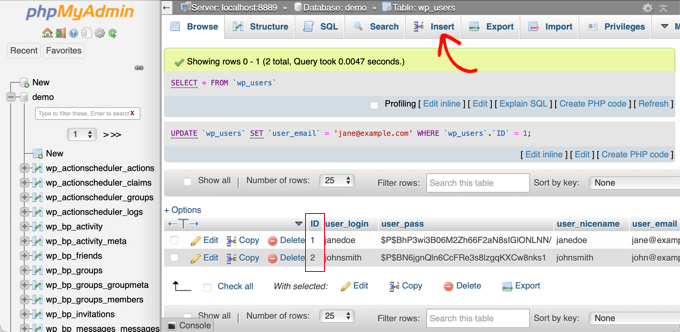
Ajoutez les informations suivantes aux champs du formulaire d’insertion :
ID: choisissez un numéro unique (dans notre exemple, nous utiliserons 3)user_login: l’identifiant qui sera utilisé pour se connecter.user_pass: ajoutez un mot de passe, et assurez-vous de sélectionner MD5 dans le menu de fonction (voir la capture d’écran ci-dessous)user_nicename: le nom complet ou le Pseudonyme de l’expéditeur.user_email: l’adresse e-mail du compte.user_url: l’adresse de votre siteuser_registered: sélectionner la date et l’heure où le compte a été inscrit à l’aide du calendrieruser_activation_key: laisser videuser_status: définir cette valeur à 0display_name: le nom complet ou le nom affiché de l’utilisateur/utilisatrice.
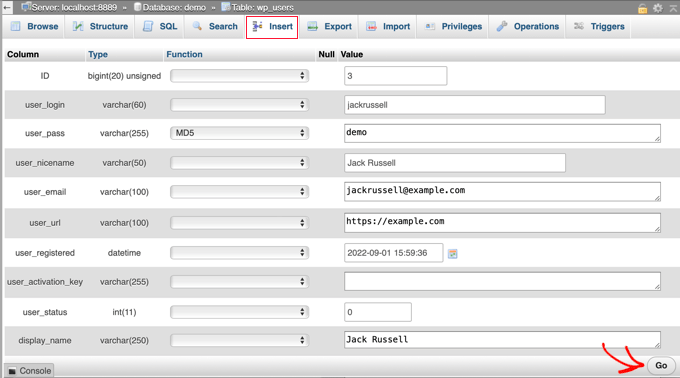
Une fois que vous avez terminé, cliquez sur le bouton “Go” pour stocker le nouvel utilisateur.
Ajout d’un compte dans la table wp_usermeta
Maintenant, vous devez trouver la table wp_usermeta et cliquer dessus. Après cela, vous devez cliquer sur l’onglet ” Insérer ” comme vous l’avez fait à l’étape précédente.
Ensuite, vous devez ajouter les informations suivantes au formulaire d’insertion :
unmeta_id: laissez ce champ vide (il sera généré automatiquement)user_id: l’ID de l’utilisateur que vous avez utilisé à l’étape précédentemeta_key: il s’agit dewp_capabilitiesmeta_value: insert this :a:1:{s:13 : "administrateur/administratrices";s:1 : "1";}
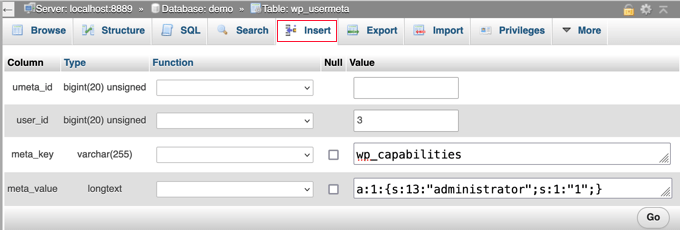
Ensuite, en défilant vers le bas, vous devriez trouver des champs pour une deuxième ligne. Vous devez ajouter les informations suivantes :
unmeta_id: laissez ce champ vide (il sera généré automatiquement)user_id: l’ID de l’utilisateur que vous avez utilisé dans les étapes précédentesmeta_key: vous devez saisirwp_user_levelvaleur_méta: 10

Lorsque vous avez saisi/saisie les informations dans les champs, vous devez cliquer sur le bouton “Go”. Félicitations, vous avez créé un nouvel identifiant d’administrateur !
Vous devriez maintenant pouvoir vous connecter à la zone d’administration de WordPress en utilisant le nom d’utilisateur et le mot de passe que vous avez spécifiés pour cet utilisateur.
Dès que vous vous connectez, vous devez naviguer vers Utilisateurs ” Tous les utilisateurs, puis cliquer sur l’identifiant que vous venez de créer.
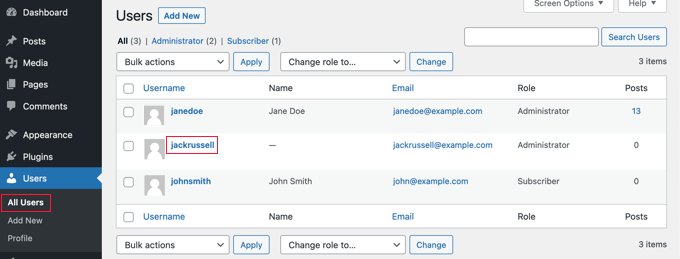
Maintenant, sans rien modifier, défilez jusqu’au bas de la page et cliquez sur le bouton “Enregistrer”.
Cela permettra à WordPress de nettoyer l’utilisateur que vous venez de créer et d’ajouter quelques informations supplémentaires qui sont nécessaires.
Ajout d’un utilisateur/utilisatrices dans la base de données de WordPress à l’aide d’une requête SQL
Si vous êtes développeur/développeuse, vous pouvez accélérer le processus en utilisant du code.
Il suffit d’Avancer cette requête SQL dans votre base de données :
1 2 3 4 5 6 7 | INSERT INTO `databasename`.`wp_users` (`ID`, `user_login`, `user_pass`, `user_nicename`, `user_email`, `user_url`, `user_registered`, `user_activation_key`, `user_status`, `display_name`) VALUES ('3', 'demo', MD5('demo'), 'Your Name', 'test@example.com', 'http://www.example.com/', '2022-09-01 00:00:00', '', '0', 'Your Name'); INSERT INTO `databasename`.`wp_usermeta` (`umeta_id`, `user_id`, `meta_key`, `meta_value`) VALUES (NULL, '3', 'wp_capabilities', 'a:1:{s:13:"administrator";s:1:"1";}'); INSERT INTO `databasename`.`wp_usermeta` (`umeta_id`, `user_id`, `meta_key`, `meta_value`) VALUES (NULL, '3', 'wp_user_level', '10'); |
Confirmez les modifications apportées à ‘databasename’ pour qu’il corresponde à la base de données avec laquelle vous travaillez.
N’oubliez pas non plus de modifier les autres valeurs pour qu’elles correspondent à celles que vous souhaitez pour le nouvel utilisateur, comme nous l’avons expliqué dans la première méthode.
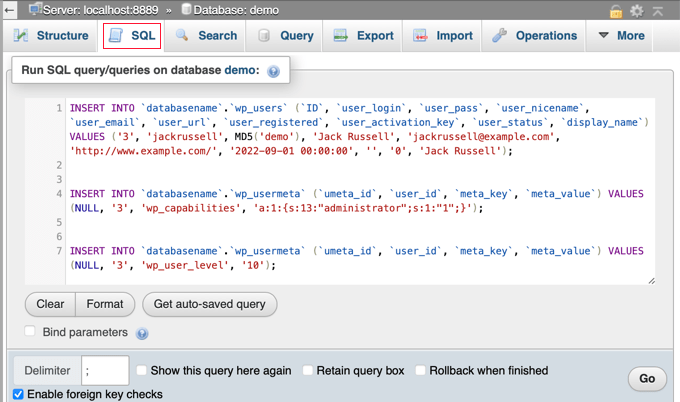
Guides d’experts sur ce qu’il faut faire lorsqu’on est bloqué dans l’administration de WordPress
Maintenant que vous savez comment ajouter un utilisateur administrateur via MySQL, vous pouvez consulter quelques articles sur la façon de corriger votre site lorsque vous êtes bloqué hors de la zone d’administration de WordPress.
- Que faire lorsque vous êtes bloqué hors de l’administration de WordPress (wp-admin)
- Comment utiliser le mode de récupération de WordPress
- Comment réinitialiser un mot de passe WordPress à partir de phpMyAdmin
- Comment débloquer la limitation des tentatives de connexion dans WordPress
- Comment désactiver toutes les extensions lorsqu’on ne peut pas accéder à WP-Admin ?
- Comment corriger l’écran blanc de WordPress (étape par étape)
- Comment corriger l’erreur critique dans WordPress (étape par étape)
- Comment corriger le problème d’actualisation et de redirection de la page de connexion de WordPress ?
- Comment Corrigé l’erreur d’établissement d’une connexion à la base de données dans WordPress
- Comment corriger facilement l’erreur “This Site Can’t Be Reached” (Ce site n’est pas accessible) sur WordPress
Nous espérons que ce tutoriel vous a aidé à apprendre comment ajouter un utilisateur/utilisatrice admin à la base de données WordPress via MySQL. Vous pouvez également consulter notre guide ultime sur la sécurité de WordPress ou notre liste d’erreurs courantes sur WordPress et comment les corriger.
Si vous avez aimé cet article, veuillez alors vous abonner à notre chaîne YouTube pour obtenir des tutoriels vidéo sur WordPress. Vous pouvez également nous trouver sur Twitter et Facebook.





zohaib
Thanks a lot, Yes I got my problem solved and this was due to the the role assigned to my user name. Cheers
Bichir Mihail
Thanks, really helpfull
Rastislav Nichta
Really very simple and clear guide to how to create a user through MYSQL WordPress database, thank you.
Mary Janis
This info is outdated cause HG format has all changed. Where the heck is wp_user?
Susan Marshall VA
Thank you so much for this. Just had a client that locked herself out of her site and I was able to get her back in with these instructions.
Kumar Mritunjay
I’ve used this on my websites. Works like a charm…very easy to follow!
Thank you for this amazing time saver technique.
sara asadiha
i did everything u said, but it did not work what else should i do?
what else should i do?
Peter Gough
Thanks for this. Really helped when I was locked out of WordPress
Michael Sineni
I have changed my admin access to editor because i was trying to change role capabilities to edit gravity forms. Suddenly i no longer see edit cornerstone or have access!! HELP!
Ayesi
Really good, everything works perfect, thanks a million!!
Stella
Thanks a lot! This saved my day. Whew!
Nilo Velez
I don’t now if it is an update to WordPress data structure, but I’ve just encounter a site in which I’ve had to enter the wp_options meta_key values as:
[table_prefix]capabilities instead of wp_capabilities
[table_prefix]user_level instead of wp_user_level
I leave this here as it might be of help.
Takis Pan
You sir are awesome!
I guess it uses the database prefix but in case the site has been moved, or someone changed the prefix from “wp_” to something else, capabilities and user_level should be changed accordingly.
Abraham Quilca
Thanks, this comment helped a lot.
I had to double-check and get the exact table_prefix value from our wp-config.php file. Ours meta_key values were correct except for capitalization. I believe some hosting companies with single-click wordpress installs will set their own table_prefixes, so be sure to check for that as well.
Cheryl
this worked for me too, thank you Abraham
Loren Helgeson
I’ve used this on three different websites so far. Works like a charm!
Thank you for this amazing time saver.
Steve Day
BRILLIANT!!!
Thank you – saved my day
Kirst
It looks like there’s been a database change in the most recent version of WP, so this post may need to be updated.
I’s been an awesome resource, thank you!
Loren Helgeson
I can’t verify this with previous versions of WordPress, but I just tested this with the latest version of WordPress, and it worked fine for me. Can anyone also confirm if this was a fluke?
Abid
I have done same sql quires to make admin user. User created and logged but showing Sorry, you are not allowed to access this page error. Please help me about this.
Jade
THANK YOU SO MUCH! I had an issue with WooCommerce Product Vendors, where I have applied as a vendor while logged in as admin. From that point on I couldn’t log in and I was receiving a message”You will be notified once your account has been approved” O_o
Previously I had to re-install WP because of this!!! Now I found your post and it was such a help!!! Thank you so much for sharing this x
x
Ben
Didn’t work at all for me. I get a “ERROR: Incorrect username or password.”
Yeah yeah, I’ve check it. Password and user are correct.
So what now? I used to have admin access but now only have a lower basic level that doesn’t show the user settings.
Loren Helgeson
This worked perfectly on the past two sites I’ve had to use it on.
SHAILENDRA RAJAVARAM
Awesome….saved me tons of hardship like for other issues. I saw that for some reason all the administrators in my site became something else…
GREAT HELP !!
The guys who discussed about wp_prefixes…..perfect….
Ah !!!
Werner Ullrich
For me it is a great helpful post. I have modified this SQL script and re-animated my door to the administrator entry of my wordpress homepage. Thanks.
Werner Ullrich
Smithg0
Okay this YouTube video is much enhanced than last one, this one has pleasant picture feature as well as audio.
Jerry L
I wanted to change several “Nicename” entries to other values than that user’s Login ID. From within PhpMyAdmin, I exported the “wp_users” table.
Then I made the necessary changes in my code editor.
Then after saving a backup of the original users table and the entire database, I “Import”ed just the “wp_users” table back into the database using PhpMyAdmin.
Worked fine for me.
Brad
Worked like a charm! Thanks!
kali
I followed this and was able to login but cannot go to the dashboard. I get this error: You do not have sufficient permissions to access this page.
Oleg
I have the same issue.
Eileen
I had the same problem but in wp_usermeta where we are told to write:
meta_value – insert this: a:1:{s:13:”administrator”;s:1:”1″;}
I changed the value to:
a:1:{s:13:”administrator”;b:1;}
and it worked. I found this value in the corresponding value further up in the table for the original administrator account. Check your table and see if there are any other previous administrators, and copy the same value (just in case it differs to my value).
Mark P
This worked for me thank you!
Ardestani
It works , thank you , really thank you
Jason Coleman
This didn’t work for me
Daniel Payne
For this to work with the latest WordPress 4.4.2 I had to update the meta_key names because my WordPress install was using a table prefix of wp_brnq_ instead of the typical wp_ prefix.
Rose
What do you mean? This is no working for me either.
Robert Drummond
Thank you for this! It saved me from an errant plugin that over-wrote my admin record in the users table!
Nadia
I am currently fixing the website of my mom for her own company and I am a kind of wordpress-dummy. I couldn’t properly log in because she sent me the wrong password. After three failed attempts it said I should look in the data. Message: ‘Username or password are not correct. Please check your data.’
I followed these steps here and I followed all of these steps very precisely, but still, with my new username and password, I am unable to log in. My prefix was different than wp_ what this article stated, so I changed the prefix as well – but can’t come through. Now I am locked out until tomorrow.
What happened, can someone maybe help me / explain me what I did wrong and how can I fix this. I really promised my mom to build her website, and it needs to be updated really soon!
Joe Harkins
you were doing a great job of step by step until you got to
“meta_key – this should be wp_capabilities”
What does “should be” mean in this context? Does it mean that it should already say that that in that field, perhaps generated from something prior? If is not there what is required?
There’s a drop down field to the right of meta_key. That file name “wp_capabilities” does not exist as a selection. There’s a blank field to the right of that. Do I paste wp_capabilities into it? Is there a value of that name somewhere that I should be putting in that field?
And I see more trouble ahead. You say “insert another row.”
I take the word insert as a verb. Where and how do I do that? I am already on the Insert page. There is nothing on it says “Insert new row.”
Looking further down – all the way at thre bottom – skipping over the next section (which I an told to do) I see a field that says “Insert as a new row.”
But “insert a new row” and being told to go to a field that contains the phrase “Inert as a new row” are not all the same thing.
and there is a checked box that says “ignore” right above it. What’s the point of going further if that box is still checked ignore – and is “insert a new row” the same as “insert a new row?”
And I see the same “should be” confusion ahead again in the next set of instructions.
But I’m stuck back the first “should” because I am literal minded. Please clarify?
Jeff
Hi Joe,
“meta_key – this should be wp_capabilities” means that the meta_key value (the textbox in phpmyadmin) should be wp_capabilities
When he refers to inserting a new row, you can do so by clicking insert from the navigation at the top of phpmyadmin this tutorial assumes you have already done the first insert and are on the browse tab.
Rich
I had a multiple site setup. After doing this I can access both sites, however I have no Network Admin capability and not Plugin management… Under “My Sites” I see my two sites, but no “Network” option. On the vertical menu area for my site I seem to have everything other than “Plugins.”
Seems I do not have Administration over my WP Network for multiple sites?
sapere aude
that was awesome! thanks.
thanks.
Bouasone
Many thank it very helpful
Russ
Thanks for the great tutorial! I was able to successfully log in.
Arpan Das
Thanks a lot. Working fine…
Rodolfo
This saved my life today – thank you!
Phil
This worked for me with the following modification: the wp_capabilities value had to be taken from another admin users row because it had additional permissions or whatever those are. copy the values in that case from an existing user if necessary
Reid Walley
If you’ve gone through all of the steps and you’re STILL getting the “You do not have sufficient permissions to access this page” error message when trying to log in…
I had to replace the first example meta_key (wp_capabilities) with my own prefix: change wp_capabilities to whateveryourprefixis_capabilities
Same with the second meta_key example (wp_user_level). I changed it to my specific prefix: change wp_user_level to whateveryourprefixis_user_level
Yoana
Thanks, that fixed it
Terry Hale
Such a helpful article. Perfectly done, easy to understand. Thanks for the time you spent putting it together.
Andre
This has been very helpful for me on several occasions. Thank you for putting this together!!!
2046
for those who still got the You do not have sufficient permissions to access this page.
you might want to check that the wp_capabilities adn stuff follows your db prefix name..
like if your normally wp_usersmeta has blab787_usersmeta the wp_capabilities will be blab787_capabilities etc.
Lydia B
Thank you, your solution to the “you do not have sufficient permissions” error message worked perfectly for me.
Terry Hale
Thanks for posting! I ran into that problem, and you solved it.
Cristian Deraco
Thank you !!! it worked for me yeah!
Rony
I can not see the table with user infomations, have any idea?
Denny
Fantastic walk-through. This is spot on with multiple versions of phpmyadmin so ignore the differences in the screenshots. Thanks for the write-up!
-D
Denny
WordPress 3.6.1. I will test this with 4 and confirm as well.
Ludwik C. Siadlak
Same here, in September 2015 I get “You do not have sufficient permissions to access this page.” error after using the SQL code provided. Which is strange, since this article is only 6 months old!
Harm
I followed your instructions to the letter but something went wrong (don’t know what) and now I don’t have access to my website. I get the message: database error.
Can I undo the changes I made? Please help.
Kiel
all I had to do was revert the meta data back to admin and it worked great. Thanks for the article.
Matthew Galvin
Pretty much useless in > version 3. Nice start tho.
Chris Hewlett
Hello, I dug a little deeper into the problem and found that existing entries in the “usermeta” table had a prefix that was unique to my site. My wordpress tables all begin with ar_, and once I edited those 2 rows to reflect that, my login was complete, with all priveleges.
Regards,
Chris
Chris Hewlett
Hello, and thank you for the above write-up on this subject. I have been locked out of my local site (XAMPP) and other articles I have read deal with changing the existing admin user password using phpMyAdmin. I did not have success with those methods.
I followed your instructions above and the login screen did accept the credentials.
Unfortunately I was redirected to domain//wp-admin/profile.php and the phrase “You do not have sufficient permissions to access this page”.
From the front end of the site, I can see I am logged in but when I click on Dashboard, the same phrase appears.
Do you have any suggestions that would allow me access?
Thanks in advance,
Chris
Abishai
Hi, tried the fix by following it to the “T” yet when I try logging in: url/wp-admin takes me to a url/25/ page as before. Wonder what I did wrong. Please advice. Thanks in advance.